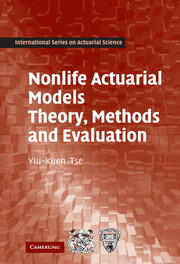Book contents
- Frontmatter
- Contents
- Preface
- Notation and convention
- Part I Loss models
- Part II Risk and ruin
- Part III Credibility
- Part IV Model construction and evaluation
- 10 Model estimation and types of data
- 11 Nonparametric model estimation
- 12 Parametric model estimation
- 13 Model evaluation and selection
- 14 Basic Monte Carlo methods
- 15 Applications of Monte Carlo methods
- Appendix: Review of statistics
- Answers to exercises
- References
- Index
10 - Model estimation and types of data
from Part IV - Model construction and evaluation
Published online by Cambridge University Press: 05 June 2012
- Frontmatter
- Contents
- Preface
- Notation and convention
- Part I Loss models
- Part II Risk and ruin
- Part III Credibility
- Part IV Model construction and evaluation
- 10 Model estimation and types of data
- 11 Nonparametric model estimation
- 12 Parametric model estimation
- 13 Model evaluation and selection
- 14 Basic Monte Carlo methods
- 15 Applications of Monte Carlo methods
- Appendix: Review of statistics
- Answers to exercises
- References
- Index
Summary
Given the assumption that a loss random variable has a certain parametric distribution, the empirical analysis of the properties of the loss requires the parameters to be estimated. In this chapter we review the theory of parametric estimation, including the properties of an estimator and the concepts of point estimation, interval estimation, unbiasedness, consistency, and efficiency. Apart from the parametric approach, we may also estimate the distribution functions and the probability (density) functions of the loss random variables directly, without assuming a certain parametric form. This approach is called nonparametric estimation. The purpose of this chapter is to provide a brief review of the theory of estimation, with the discussion of specific estimation methods postponed to the next two chapters.
Although the focus of this book is on nonlife actuarial risks, the estimation methods discussed are also applicable to life-contingency models. Specifically, the estimation methods may be used for failure-time data (life risks) as well as loss data (nonlife risks). In many practical applications, only incomplete data observations are available. These observations may be left truncated or right censored. We define the notations to be used in subsequent chapters with respect to left truncation, right censoring, and the risk set. Furthermore, in certain setups individual observations may not be available and we may have to work with grouped data. Different estimation methods are required, depending on whether the data are complete or incomplete, and whether they are individual or grouped.
- Type
- Chapter
- Information
- Nonlife Actuarial ModelsTheory, Methods and Evaluation, pp. 281 - 300Publisher: Cambridge University PressPrint publication year: 2009

